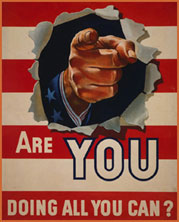
Source: Home front image 1, Library of Congress

Source: Home front image 1, Library of Congress
Every aspect of the lives of Americans was affected by the war. There was an increased wave of patriotism immediately following the bombing of Pearl Harbor. Americans from all walks of life participated in acts of patriotism that encapsulated the United States during the war.
The Office of War Information managed a campaign to encourage patriotism through a series of posters. Click on the link below to look at a slideshow of posters from World War II.
Newspapers and radio programming were geared toward reporting the war and keeping civilians informed. There were songs and movies produced with patriotic themes. Actors, singers, and other entertainers traveled across the country to entertain the troops.
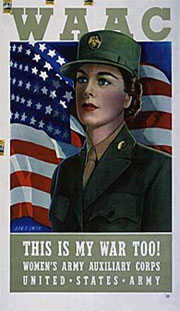
Source: Poster, Poster 133, Minnesota Historical Society
Men and women voluntarily enlisted into the armed forces in record numbers. By the end of the war, there were more than 12 million members of the United States Armed Forces. More than 350,000 women served in the U.S. military and more than 70,000 served as Army and Navy nurses.
In 1942, President Roosevelt created the Women’s Auxiliary Forces, which included branches of the military specifically for women. The following is a list of Women’s Auxiliary Forces:
Women were not allowed to participate in armed conflict, and most women in the military served in roles that were considered traditional female jobs. These jobs included clerks, secretaries, and mail sorters. These positions were important to military functions because they kept the flow of communication moving. Women who served in the medical corps faced more danger because their work was usually performed closer to the front lines.
Although all Americans were working toward a victory in World War II, many of the social problems that plagued the United States also followed American troops to war. At the beginning of the U.S. involvement in the war, the military was segregated. African-American troops lived, worked, and relaxed in separate facilities. They had separate training and were then placed in separate military units, which were led by white officers.
African-American soldiers were frequently assigned to supply units instead of combat. Although these soldiers were discriminated against at home and in the military, they proudly served their country in the war.
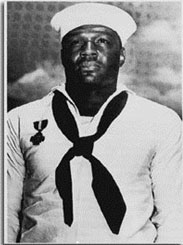
Source: Doris Miller, National Archives
An example of such bravery came on the day that the Japanese attacked Pearl Harbor. Doris Miller was a mess attendant (cook) on the U.S.S. West Virginia at the time of the attack. Despite enemy strafing and bombing, Miller helped move his mortally wounded Captain to a place of greater safety. He then manned and fired a machine gun against the attacking Japanese planes until ordered to leave the ship's bridge.
In the African-American community, Miller’s actions were a source of pride. Miller continued his service in the navy until he died when the U.S.S. Liscome Bay was sunk by a Japanese submarine torpedo in 1943.
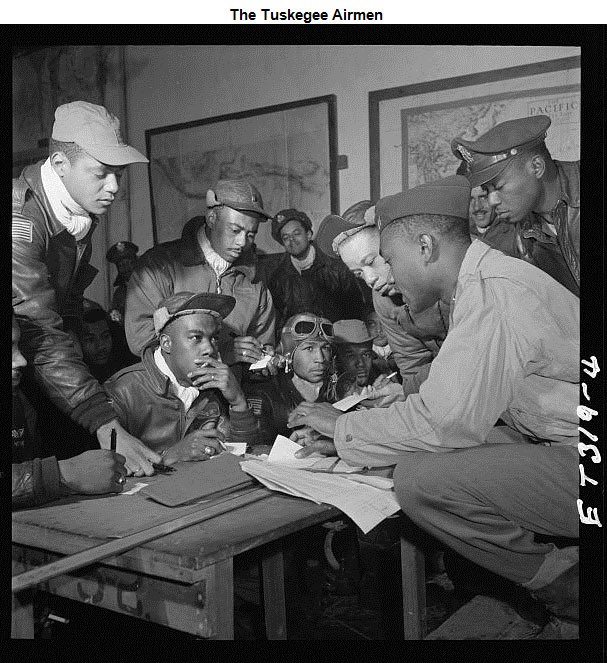
Source: [Photograph of several Tuskegee airmen at Ramitelli, Italy, March 1945], Tony Frisell, Library of Congress
During the time that most African American soldiers were relegated to duties such as cooking and cleaning, a heroic group of African Americans known as the Tuskegee Airmen emerged. The Tuskegee Airmen was a group of specially trained African-American combat pilots who studied at Tuskegee Institute in Tuskegee, Alabama. The Tuskegee Airmen were assigned the task of escorting American bomber planes flying missions over enemy territory in Europe.
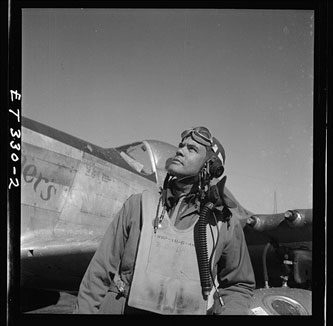
Source: Col. Benjamin O. Davis, air base at Rametti, Italy, Toni Frissell, Library of Congress
Colonel Benjamin O. Davis commanded the Tuskegee Airmen. In combat over Europe, they shot down more than 100 enemy planes without losing one of the American bombers they escorted. Davis would later become the first African-American general in the U.S. Air Force.
While segregation persisted in the armed forces, some change came on the home front. A. Philip Randolph, an African-American labor leader, presented President Roosevelt with a list of grievances regarding the civil rights of African-American workers in the nation’s defense industry. Randolph planned a huge protest march in Washington, D.C., if the demands were not met. Fearing such a protest would undermine wartime unity, President Roosevelt issued Executive Order 8802, banning discriminatory employment practices by Federal agencies and all unions and companies engaged in war-related work. Click on the link below to view a video about A. Philip Randolph and the March on Washington Movement.
Source: WWII & NYC: March on Washington, New York Historical Society, YouTube
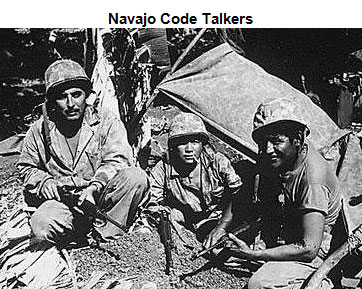
Source: Navajo Code Talkers, Bradipus, Wikimedia
A special group of American Indians called the Navajo Code Talkers was another group that made an important contribution to World War II. The Navajo Indians were recruited to transmit and recieve secretly coded radio communications for the U.S. Marines. This was essential because enemy forces intercepted and listened to radio transmissions pertaining to Marine maneuvers and combat.
The Navajo Code Talkers developed a secret code of communication based on the Navajo language. The enemy was unable to decode the Navajo language, thus making the Navajo Code Talkers essential to the success of the Allies during World War II. Click on the link below to view and hear the story of the Navajo Code Talkers.
Over 500,000 Latinos (including 350,000 Mexican Americans) served in World War II. Unlike African Americans, they were not segregated into separate units. Latino soldiers who were fluent in Spanish served an important role in fighting in the Philippines. Their knowledge of Spanish was invaluable when serving with Spanish speaking Filipinos. In Europe, Latino soldiers from the 36th Infantry Division from Texas were among the first soldiers to land in Italy. Seventeen Medals of Honor have been awarded to Latinos for service during World War II. Click on the link below to learn more from the National WWII Museum.
Latino Americans in World War II
While women and minorities were making contributions to the war overseas and at home, they still faced the obstacles of a country that continued to foster inequality and discrimination. Click on the images below to learn more about the struggles of some of the ethnic minorities in the United States.
Japanese-American Relocation |
Detroit Race Riots |
Zoot Suit Riots |
A Japanese man is standing in the doorway of a cabin in an internment camp in Arizona. |
A mob of white people is surrounding a bus on a city street in Detroit during the race riots. |
U.S. sailors and other members of the armed forces are walking the streets of Los Angeles. |

The migration of African Americans did not start with the job opportunities that World War II presented. African Americans had migrated to Northern and Midwestern cities for decades. Detroit was a popular destination among African-American families. This movement, however, created racial tensions that were intensified when African Americans moved to the city during World War II. Because of the racial conflicts in the city, African Americans had no choice but to live in a designated part of town, which had poor living conditions.
On June 20, 1943, several fights erupted between African-American and white teenagers. The violence escalated, involving thousands of blacks and whites over several days. Mobs attacked each other as well as innocent motorists, pedestrians, and streetcar passengers. Stores were looted and buildings were burned in both black and white neighborhoods. The violence ended only after President Roosevelt ordered 6,000 federal troops into the city. Twenty-five blacks and nine whites were killed in the violence.

The Zoot Suit Riots were a series of riots between white sailors and Mexican-American youths in Los Angeles in 1943. Prior to the riots, ethnic tensions were high because many white Americans did not welcome the wartime increase in temporary workers from Mexico. The riots were named for the “zoot suits” of baggy pants and long jackets that Mexican-American youths favored even though wartime rationing regulations prohibited manufacturing of the suits.
On June 3, 1943, U.S. sailors roamed the Mexican-American sections of Los Angeles attacking “zooters.” By June 7, thousands of sailors and civilians joined the attacks. Luckily, no one was killed. In response to the riots, the police arrested hundreds of Mexican-American youths.

Upon entry into World War II, the United States was charged with fighting a multi-front war. The United States Armed Forces fought in both the European and Pacific Theaters, while American civilians supported the war from the American home front.
Those on the home front supported the war in many ways. Men and women enlisted in the military in record numbers. Americans showed their patriotism by supporting the victory programs created by government agencies.
The wartime economy presented women and minorities with new job opportunities. Although the war presented Americans with new opportunities, American society was still plagued by social issues such as racial tensions and discrimination.
Sources for images used in this section, as they appear: